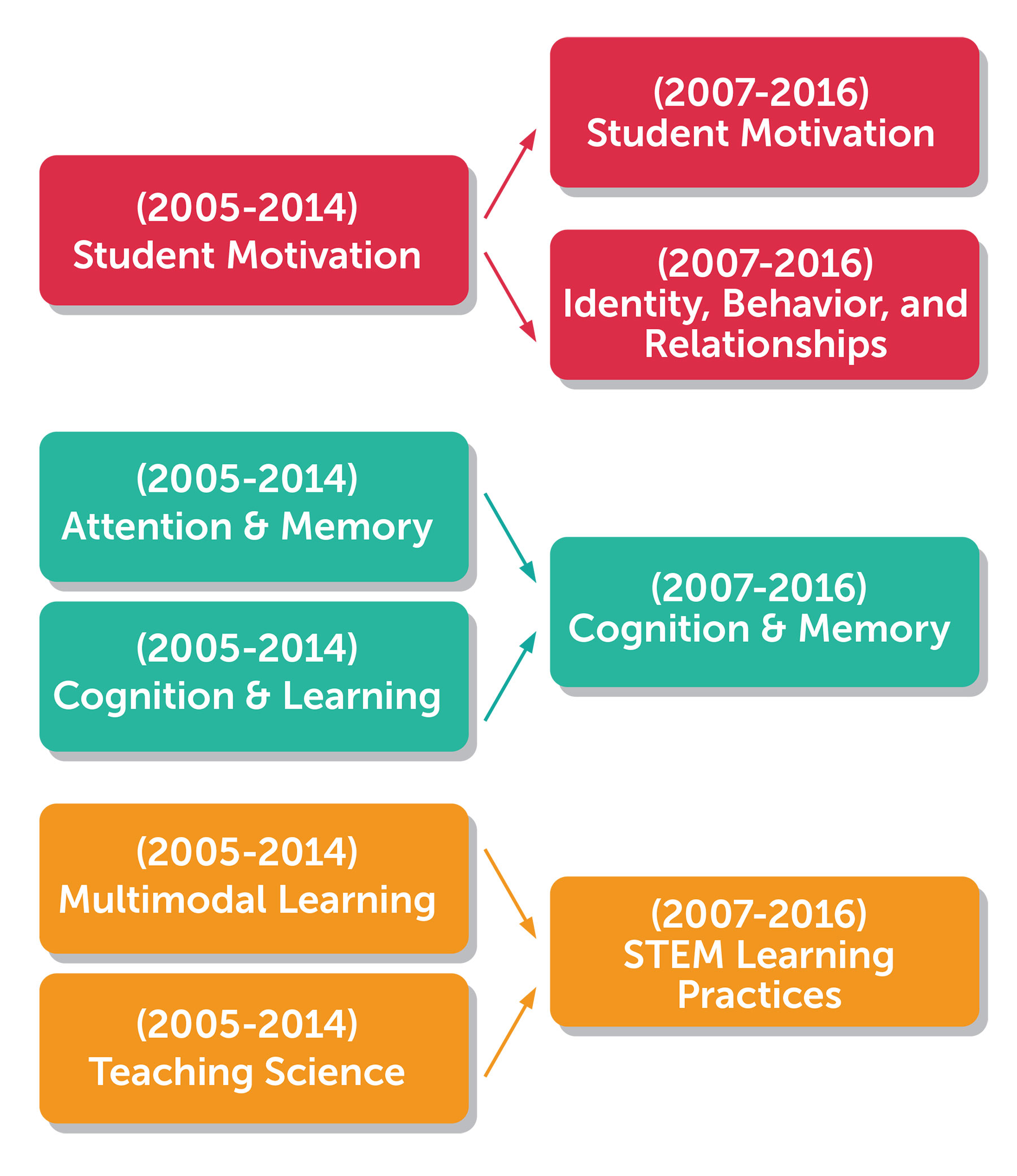
June 15, 2017 | By Aubrey Francisco and Babe Liberman
Busy education leaders and entrepreneurs don’t have time to sift through hundreds of papers, and often don’t know where to start. Still, there are increasing calls for educators and entrepreneurs alike to design and implement innovative education programs and products based on learning science findings.
In 2016, we launched the Research Map to provide education stakeholders a visual way to explore the full landscape of education and learning science research. Since then, more than 20,000 web users have visited the map, and many have offered valuable feedback on what’s working well and how it could be improved. We’re excited to share an updated version of the Research Map, which features the latest research and new ways to access relevant learning science findings.
The new data visualization is based on over 100,000 peer-reviewed articles from 184 journals published between 2007 and 2016. Our analysis of these publications revealed 11 broad topics, such as Student Motivation and Cognition & Memory, which are broken down into more than 120 subtopics. Below, we highlight new features and topics to explore.
In addition to being able to access research, many users wanted to see how research can be applied in the real world. We created the Research@Work video series to help illustrate key research concepts in practice, such as a framework for fostering student motivation and strategies for helping students with low working memory become proficient readers.
Many educators also wanted specific, research-based suggestions for addressing specific challenges in their schools and classrooms. In response, we collaborated with Harvard’s Usable Knowledge to launch the Ask a Researcher project, which provides research-informed answers to questions from practitioners across the country.
Additionally, many users reported turning to the topic pages, which translate relevant and actionable research concepts, to find information and practical resources related to challenges their districts are facing. For example, Dr. Matt Doyle, Interim Superintendent for Vista Unified School District, shared that he and his colleagues have turned to resources from the Special Education Practices topic page to figure out how to effectively support diverse learners in their district. To stay up to date, we’ve updated these topic summary pages with new key findings and links to over 75 curated resources. To make these pages easier to navigate, we’ve also added bookmarks to each topic page. For example, on the STEM Learning Practices page you can click directly to findings related to STEM Education or Multimedia Learning, depending on your interest.
Comparing our latest analysis of articles published between 2007 and 2016 to the previous analysis of papers published between 2005 and 2014 provides some insight into how the broad field of learning science is shifting. Topics and subtopics in the map represent clusters of articles that frequently cite one another; therefore, analyzing a more recent set of articles shows shifts in patterns of citations, and reveals new topics and subtopics.

For instance, the Student Motivation topic from the previous version of the map has split in two, forming the new Identity, Behavior, and Relationships topic, which includes a range of research articles related to early childhood education, social emotional learning, and family engagement. The Student Motivation topic now features a more specific set of research on fostering motivation and positive mindsets in students. This may suggest an increasing research focus on what are often referred to as “non-cognitive” factors or “character skills.”
Another new topic, STEM Learning Practices, formed from the merging of the Multimodal Learning and Science Teaching topics from the previous map. This topic explores the optimal conditions for learners to acquire STEM knowledge, skills, and understanding and includes studies on multimedia learning, how students learn from models and explanation, and technology’s role in enhancing learning environments. While it’s not entirely clear why these topics have merged in the learning science field, it may suggest digital multimedia tools are more often studied in STEM classes.
Finally, the Cognition & Learning and Attention & Memory topics from the previous map have merged to form the new Cognition & Memory topic: one large topic that includes research on cognitive science theories about how the brain processes information and explores the relationship between memory and learning. This suggests increased interaction between researchers across these related fields. In addition, a new subtopic, Creativity & Cognition, has emerged, without an equivalent in the previous map.
In the year ahead we’ll keep working to improve the map site. We will add pages featuring emerging or buzzworthy topics that are new enough to not yet be featured on the map. We will also conduct research and outreach to determine which emerging topics – whether maker education, personalized learning, or something else – our audience is most interested in. And, as an organization, Digital Promise will continue to make research on learning more accessible and directly connect researchers and practitioners in order to support educators and developers in actively implementing research-informed practices.
By Sharin Jacob and Quinn Burke
By Dr. Kyle Dunbar and Katie Wilczak
By Elliott Barnes and Sara Mungall